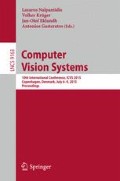Abstract
We present a vision-based approach for analyzing a Parkinson patient’s movements during rehabilitation treatments. We describe therapeutic movements using relevant quantitative measurements, which can be applied both for diagnosis and monitoring of the disease progress.
Since our long-term goal is to develop an affordable and portable system, suitable for home usage, we use the Kinect device for data acquisition. All recorded exercises are approved by neurologists and therapists and designed to examine the presence of characteristic symptoms caused by neurological disorders. In this study, we focus on Parkinson’s patients in the early stages of the disease.
Our approach underlines relevant rehabilitation measurements and allows to determine which ones are more informative for separating healthy from non-healthy subjects. Finally, we propose the symmetry ratio, well known in motor control, as a novel feature that can be extracted from rehabilitation exercises and used in the decision-making (diagnosis support) and monitoring procedures.
Access this chapter
Tax calculation will be finalised at checkout
Purchases are for personal use only
References
Goetz, C., Tilley, B., Shaftman, S., et al.: Movement disorder society-sponsored revision of the unified parkinson’s disease rating scale (mds-updrs): scale presentation and clini-metric testing results. Mov. Disord. 22, 2129–2170 (2008)
Zhou, H., Hu, H.: Human motion tracking for rehabilitation – a survey. Biomed. Sign. Process. Control 3, 1–18 (2008)
Patel, S., Park, H., Bonato, P., et al.: A review of wearable sensors and systems with application in rehabilitation. J. NeuroEngineering Rehabil. 9, 21 (2012)
Gonzalez-Jorge, H., Riveiro, B., Vazquez-Fernandez, E., et al.: Metrological evaluation of microsoft kinect and asus xtion sensors. Measurement 46, 1800–1806 (2013)
Khoshelham, K., Elberink, S.: Accuracy and resolution of kinect depth data for indoor mapping applications. Sensors 12, 1437–1454 (2012)
Clark, R., Pu, Y., Fortina, K., et al.: Validity of the microsoft kinect for assessment of postural control. Gait Posture 36, 372–377 (2012)
Chang, C., Lange, B., Zhang, M., et al.: Towards pervasive physical rehabilitation using microsoft kinect. In: Proceedings of PervasiveHealth, pp. 159–162 (2012)
Chang, Y., Han, W., Tsai, Y.: A kinect-based upper limb rehabilitation system to assist people with cerebral palsy. Res. D. Disabil. 34, 3654–3659 (2013)
Chang, Y., Chen, S., Huang, J.: A kinect-based system for physical rehabilitation: a pilot study for young adults with motor disabilities. Res. Dev. Disabil. 32, 2566–2570 (2011)
Gama, A., Chaves, T., Figueiredo, L., et al.: Guidance and movement correction based on therapeutics movements for motor rehabilitation support systems. In: 14th Symposium on Virtual and Augmented Reality (2012)
Calin, A., Cantea, A., Dascalu, A., et al.: Mira – upper limb rehabilitation system using microsoft kinect, studia univ. babes-bolyai. Informatica 56(4), 63 (2011)
Galna, B., Barry, G., Jackson, D., et al.: Accuracy of the microsoft kinect sensor for measuring movement in people with parkinson’s disease. Gait and Posture (2014). http://dx.doi.org/10.1016/j.gaitpost.2014.01.008
Galna, B., Jackson, D., Schofield, G., McNaney, R., et al.: Retraining function in people with parkinson’s disease using the microsoft kinect: game design and pilot testing. J. Neuroengineering Rehabil. 11, 11–60 (2014)
Albiol-Pérez, S., Lozano-Quilis, J., Gil-Gómez, H., et al.: Virtual rehabilitation system for people with Parkinson’s disease. In: 9th International Conference on Disability, Virtual Reality and Associated Technologies (ICDVRAT), pp. 423–427 (2012)
Lange, B., Koenig, S., McConnell, E., et al.: Interactive game-based rehabilitation using the microsoft kinect. In: Virtual Reality Short Papers and Posters IEEE, pp. 171–172 (2012)
Lum, P., Burgar, C., Shor, P., et al.: Robot-assisted movement training compared with conventional therapy techniques for the rehabilitation of upper-limb motor function after stroke. Arch. Phys. Med. Rehabil. 83, 952–959 (2002)
Vaisman, L., Dipietro, L., Krebs, H.: A comparative analysis of speed profile models for wrist pointing movements. IEEE Transactions on Neural Systems and Rehabilitation Engineering 21(5), 756–766 (2013)
Plamondon, R.: A kinematic theory of rapid human movements. Part I. movement representation and generation. Biol. Cybern. 72, 295–307 (1995)
Gribble, P., Ostry, D.: Origins of the power law relations between movement velocity and curvature: modeling the effects of muscle mechanics and limb dynamics. J. Neurophysiol. 76, 53–59 (1996)
Bullock, D., Grossberg, S.: Adaptive neural networks for control of movement trajectories invariant under speed and force rescaling. HMS 10, 3–53 (1991)
Mirkov, D., Milanovic, S., Ilic, D., et al.: Symmetry of discrete and oscillatory elbow movements: does it depend on torque that the agonist and antagonist muscle can exert? Mot. Control 6, 271–281 (2002)
Hoehn, M., Yahr, M.: Parkinsonism: onset, progression and mortality. Neurology 17, 427–442 (1967)
Keus, S., Bloem, B., Hendriks, E., et al.: Evidence-based analysis of physical therapy in parkinson’s disease with recommendations for practice and research. Mov. Disord. 22(4), 451–460 (2007)
Fisher, R.A.: The use of multiple measurements in taxonomic problems. Ann. Eugenics 7, 179–188 (1936)
Acknowledgment
This work was funded by the Ministry of Education, Science and Technology Development of the Republic of Serbia under the contracts TR-35003, III-44008 and III- 44004; the EU Project POETICON ++, the Portuguese FCT Project [UID/EEA/50009/2013] and the Alexander von Humboldt project “Emotionally Intelligent Robots - EIrobots”, Contract no. 3.4-IP-DEU/112623.
Author information
Authors and Affiliations
Corresponding author
Editor information
Editors and Affiliations
Rights and permissions
Copyright information
© 2015 Springer International Publishing Switzerland
About this paper
Cite this paper
Spasojević, S., Santos-Victor, J., Ilić, T., Milanović, S., Potkonjak, V., Rodić, A. (2015). A Vision-Based System for Movement Analysis in Medical Applications: The Example of Parkinson Disease. In: Nalpantidis, L., Krüger, V., Eklundh, JO., Gasteratos, A. (eds) Computer Vision Systems. ICVS 2015. Lecture Notes in Computer Science(), vol 9163. Springer, Cham. https://doi.org/10.1007/978-3-319-20904-3_38
Download citation
DOI: https://doi.org/10.1007/978-3-319-20904-3_38
Published:
Publisher Name: Springer, Cham
Print ISBN: 978-3-319-20903-6
Online ISBN: 978-3-319-20904-3
eBook Packages: Computer ScienceComputer Science (R0)

